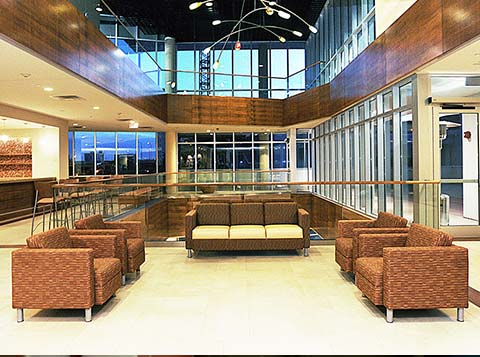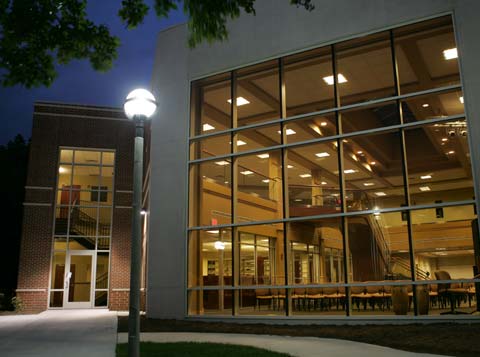
By RaeAnn Slaybaugh

Showcasing eco-friendly components in your new-build project conveys good stewardship — financial and environmental.
For the majority of clients, aiming for full Leadership in Energy & Environmental Design (LEED) certification for a new building isn’t cost-effective, as it often costs several to tens of thousands of dollars above and beyond construction costs. Charles Kluger, principal at Kluger Architects, Inc. in Signal Hill, CA, explains why.
For one thing, Kluger’s firm must be part of the US Green Building Green Council, which is fee-based. Second, he says, LEED certification is an extensive process that often involves third-party consulting to achieve.
Tim Black of CDH Partners in Marietta, GA — who designed LEED-certified (silver) First United Methodist Church in Orlando — agrees that these projects are the exception, not the rule. “It usually comes down to bottom-line costs. Even administrative costs associated with pursuing the certification can be cost-prohibitive,” he acknowledges.
Even so, as Black points out, this doesn’t mean churches don’t embrace green design. “In fact, they’re intrinsically motivated to do the right thing and not waste resources — financial or environmental,” he says.
READER SNAPSHOT:
Nearly 23% will embark on a construction project within 18 months.
Source: “The Church Executive Reader Survey”
Kluger agrees and says many church clients elect for green elements in their projects — especially if they’re implemented early and are “passive” by design. “Passive energy systems don’t relate to something you buy,” he explains. “It’s how you orient and design the building itself.”
As an example, Kluger cites St. Finbar, a parish hall and multipurpose building project in Burbank, CA. Here, he and his team accounted for prevailing wind directions by designing the building with high windows which open to provide passive cooling in the large hall. The wind pulls the high heat from the building and creates suction of the cooler air to flow upward from the ground.
They also located the A/C units on the roof, on the negative side of the building, which took advantage of the air moving away from the building. In doing so, it allows sound and air to flow across the units and away from the facility.

Additionally, decorative masonry block was chosen for the exterior and interior finish. It helps keep the building cool and needs no maintenance.
Similarly, Brad Lechtenberger, project architect for Churches by Daniels Construction, Inc., in Broken Arrow, OK, has found church clients very receptive to green construction elements — often in an effort to balance budgetary constraints with long-term use and costs needs. In particular, he says clients have embraced locally sourced and manufactured materials (which reduce carbon emissions associated with long-distance shipping), as well as structural components from renewable sources — wood products — and steel structural elements with a high recycled-material content.
They also appreciate mechanical systems with a high SEER, or Seasonal Energy Efficiency Rating, he points out. “The higher the rating, the more energy-efficient the system will be.”
Combatting green misconceptions
Although conventional wisdom says green construction elements are more expensive, upfront, it really depends on a handful of factors.
“For instance, here in California — and in many other states — local and state codes require a certain percentage of a project to be reuseable, recycable or ‘green,’” Kluger says. Depending on jurisdiction, the code requirements can be as much as 20 percent, if not more. (In Los Angeles, for example, it can be as high as 35 percent — even for tear-down projects.)
For his part, Lectenberger says green elements don’t have to be more expensive, if they’re part of early planning. “Certain elements can greatly reduce the amount of energy spent during the manufacture / construction period of the facility, and then over the life of the church facility.”
Finally, Black says that while certain energy-efficient elements (solar panels and energy-efficient HVAC systems, for example) might still cost more than their counterparts, the industry has “almost flipped.”
“Now, they embrace green offerings at a low price point,” he says.
A sum of its parts
According to the architects, several elements represent the most immediate opportunities to embrace green construction. They are:
Energy-efficient lighting. For Lechtenberger and his team, LED is quickly becoming the main lighting system in their church designs — not only for stage/specialty use, but for all facilities.
“LED has great advantages over the old incandescent lighting systems,” he says. “It uses a fraction of the energy, and a fixture’s life span is measured in years rather than weeks or months.” On the back end, clients save “a tremendous amount of money” in energy and maintenance costs, according to Lechtenberger.
Kluger agrees. Conservatively, he estimates switching to LED bulbs represents a lifetime cost savings of 20 percent to 30 percent versus incandescent lighting. “For a parking lot lighting project we’re working on right now, we switched to LED from incandescent,” he says. “The church will recoup the higher investment cost within seven years.”
Black has had a similar experience: “In fact, the industry now makes it difficult not to use energy-efficient lighting as it phases out incandescent bulbs.”
Carpets. Given the high recyclable content of many contemporary carpets, it’s perhaps the simplest of all green construction elements to incorporate. “Actually, almost all interior finishes have a green focus now,” Black says. “It’s all headed in a sustainable, recyclable direction.”
Windows. Kluger, Lechtenberger and Black all like to use low-thermal-emissivity (“low-E”) glass in their church projects.
Although Kluger concedes that dual-glazed and low-E glass is more expensive upfront, both are “almost a requirement” in California. It pays off in the long run, in air-conditioning and heating cost savings.
Black concurs and says energy codes now include minimum-energy-efficiency standards when it comes to windows.
Everything (including) the kitchen sink. Other green elements Kluger often works into his church projects include automatic-on/off faucets and toilets, as well as waterless urinals.
For Lechtenberger’s part, he pays careful attention to the design of the exterior wall and roof envelope systems. “It relates to proper insulation/thermal bridging and the reduction of air infiltration,” he explains.
Plants / landscaping. At St. Finbar, drought-tolerant plants — including olive and palm trees — are a welcome, eco-friendly option. And, as Kluger points out, both lend themselves well to religious symbolism: “Clients sometimes plant 12 palm trees to represent 12 apostles.”
Feature photo: First United Methodist Church in Orlando, a LEED-certified (silver) facility (Photo courtesy of Jacque Photo, LLC/CDH Partners)

